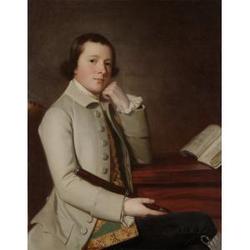Here are two little causes for joy: a reattribution, in Dallas, and a reclamation-release, in New York.
 Yesterday the Dallas Museum of Art announced that it owned a George Romney, not a painting by an unknown, probably American colonial artist, perhaps Ralph Earl. “Young Man With A Flute” entered the collection as part of a bequest in 1987.
Yesterday the Dallas Museum of Art announced that it owned a George Romney, not a painting by an unknown, probably American colonial artist, perhaps Ralph Earl. “Young Man With A Flute” entered the collection as part of a bequest in 1987.
Ten years ago, a British art dealer named Phillip Mould suggested that the painting might be by Romney, but had no evidence and the museum paid scant attention. This year, when Olivier Meslay, the senior curator of European and American Art, arrived from the Louvre, saw the painting and learned of Mould’s suspicion, he decided to investigate. Eventually, Romney expert Alex Kidson, the consultant curator with the National Museums Liverpool, saw and analyzed the painting, determining that it was indeed by Romney, a key figure in 18th-century British art and a contemporary of Sir Joshua Reynolds and Thomas Gainsborough.
The painting hangs next to a Reynolds at the DMA. Read more in the museum’s press release.
 In New York, the story is curiouser. In 1971, Faith Ringgold was commissed to paint a mural at Riker’s Island, which then held women prisoners as well as men. “For the Women’s House,” her first public commission, depicted women in various forms of work and was hung in the cafeteria of the Women’s House of Detention. In the early ’90s, when RI became all-male, it was painted over, moved to the basement and slated for disposal. Luckily, a female guard contacted Ringgold, who appealed to the Corrections Commissioner, and the painting was restored — but rarely seen.
In New York, the story is curiouser. In 1971, Faith Ringgold was commissed to paint a mural at Riker’s Island, which then held women prisoners as well as men. “For the Women’s House,” her first public commission, depicted women in various forms of work and was hung in the cafeteria of the Women’s House of Detention. In the early ’90s, when RI became all-male, it was painted over, moved to the basement and slated for disposal. Luckily, a female guard contacted Ringgold, who appealed to the Corrections Commissioner, and the painting was restored — but rarely seen.
Until now: On Tuesday, the Rikers Island warden told the Neuberger Museum of Art that it would lend the mural to its coming People, Black Light: Faith Ringgold’s Paintings of the 1960s. It will be there when the exhibition opens on Saturday.
The things art works go through.
